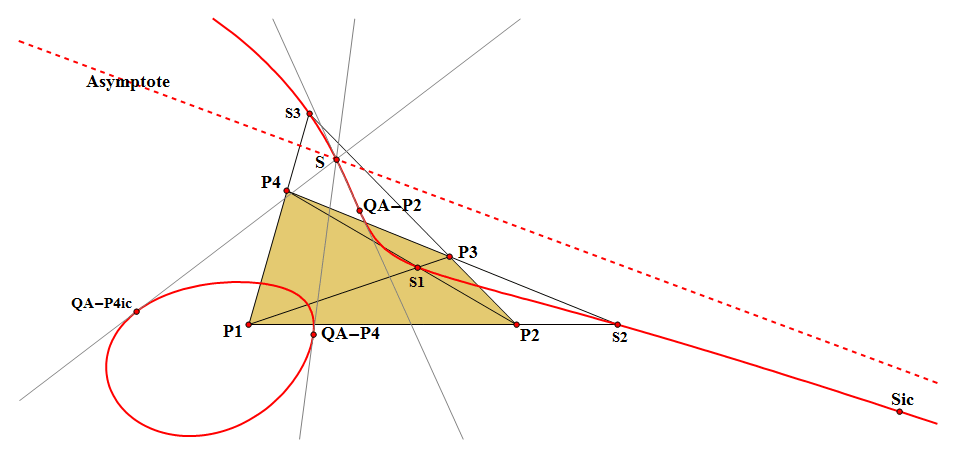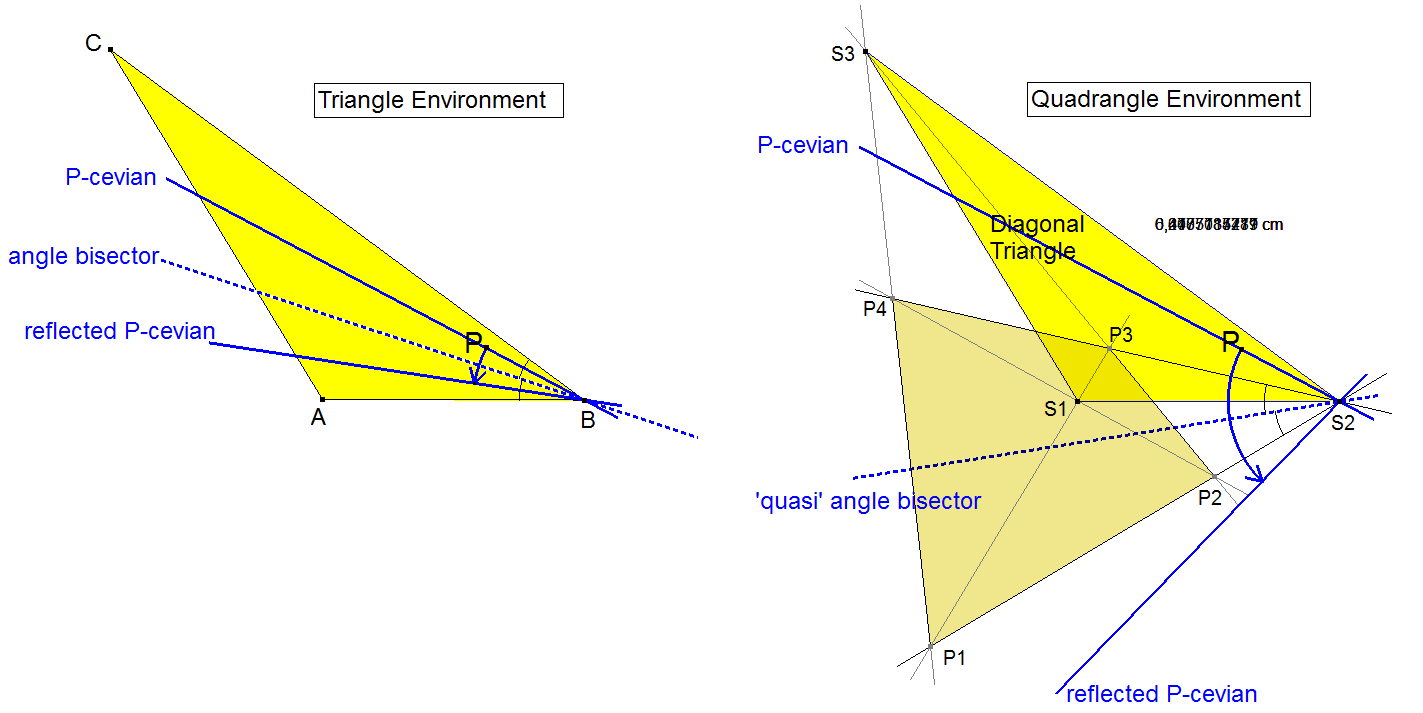QA-Cu7: QA-Quasi Isogonal Cubic
QA-Cu7 is the locus of all points Q for which the 3 Reflections of the line Q.Si in the angle bisectors of Si concur, where Si = ith vertex of the QA-Diagonal Triangle (i = 1,2,3). See also QG-Tf2 (Quasi Isogonal Conjugate).
The concurring point is also a point of the locus.
With the Reference Quadrangle as reference system this cubic can be seen as a circular isocubic invariant to the Involutary Conjugacy.
Construction: it is the locus of the intersection pint of the involutary conjugate of some line through QA-P4 and its perpendicular line through QA-P4 (note Eckart Schmidt). See QA-Cu-1, QA-Cubic Type 2.

QA-P4ic = Involutary Conjugate of QA-P4 = QA-P41,
Sic = Involutary Conjugate of S and the intersection of QA-P4.QA-P41 and perpendicular line in QA-P2 wrt QA-L2.
S is the intersection of QA-Cu7 and its asymptote
- or the intersection of the tangents in QA-P2, QA-P4, QA-P41
- or the diametral point of QA-P41 on the circumcircle of QA-P2, QA-P4, QA-P41 with Simson line QA-L2. See [34], Eckart Schmidt, QFG#1840.
Equation CT-notation:
– b2 c2 p2 Tx (-q r x + p r y + p q z) x2
– a2 c2 q2 Ty ( q r x – p r y + p q z) y2
– a2 b2 r2 Tz ( q r x + p r y – p q z) z2
+ Txyz x y z
where:
Tx = c2 q2 – a2 q r + b2 q r + c2 q r + b2 r2,
Ty = c2 p2 + a2 p r – b2 p r + c2 p r + a2 r2
Tz = b2 p2 + a2 p q + b2 p q – c2 p q + a2 q2
Txyz = b2 c2 p4 + a2 c2 q4 – a2 (a2 – b2 – c2) q3 r + a2 (a2 + b2 + c2) q2 r2 – a2 (a2 – b2 – c2) q r3 + a2 b2 r4 + p3 (c2 (a2 + b2 – c2) q + b2 (a2 – b2 + c2) r) + p2 (c2 (a2 + b2 + c2) q2 + (a4 – a2 b2 – a2 c2 + 4 b2 c2) q r + b2 (a2 + b2 + c2) r2) + p (c2 (a2 + b2 – c2) q3 + (-a2 b2 + b4 + 4 a2 c2 – b2 c2) q2 r + (4 a2 b2 – a2 c2 – b2 c2 + c4) q r2 + b2 (a2 – b2 + c2) r3)
Equation DT-notation:
((b2 c2 p4 + a4 q2 r2) SA + p2 (c2 q2 + b2 r2) (S2 + SB SC)) (r2 y2 + q2 z2) x
+((a2 c2 q4 + b4 p2 r2) SB + q2 (c2 p2 + a2 r2) (S2 + SA SC)) (r2 x2 + p2 z2) y
+((c4 p2 q2 + a2 b2 r4) SC + (b2 p2 + a2 q2) r2 (S2 + SA SB)) (q2 x2 + p2 y2) z
+(a2 b2 (b2 p2 + a2 q2) r4 + a2 c2 q4 (c2 p2 + a2 r2) + b2 c2 p4 (c2 q2 + b2 r2)
+ 2 p2 q2 r2 (3 SA SB SC + S2 (SA + SB + SC))) x y z = 0
Properties
-
- These points lie on QA-Cu7:
- the vertices of the QA-Diagonal triangle,
- QA-P2 (Euler-Poncelet Point),
- QA-P4 (Isogonal Center)
- QA-P41 (Involutary Conjugate of QA-P4)
- the Involutary Conjugate of QA-P2 is the infinity point that represents the asymptote of the cubic.
- the 3 QA-versions of QG-P18 (Quasi Isogonal Crosspoint)
- the 3 QA-versions of QG-P19 (Quasi Isogonal Conjugate of QG-P1)
- the circular points at infinity, which makes the cubic called circular.
- The Asymptote is perpendicular to QA-L2 = QA-P2.QA-P4.
- The Asymptote // 5th Point tangent of QA-P2 (see QA-Tf9).
- The Involutary Conjugate of every point on the cubic also lies on the cubic.
- The cubic is “self-involutary”.
- The tangents at QA-P2, QA-P4 and QA-P4ic pass through the intersection point S of the asymptote and the cubic.
- QA-Cu7 is the locus of all pairs of involutary conjugated points for which the Thales circle passes through QA-P4 (note Eckart Schmidt).
- Any line though Pi, Pj (Pi,Pj are two of the four points P1, P2, P3, P4) intersects QA-Cu7 in one of the QA-DT-vertices and a pair of points (T1, T2).
- Now (T1, T2) are harmonic conjugated with (Pi, Pj).
- Let (Pk, Pl) be the other pair of points of the Quadrangle. Again Pk.Pl intersects QA-Cu7 in one of the QA-DT-vertices and a pair of points (U1, U2). Similarly (U1, U2) are harmonic conjugated with (Pk, Pl).
- Now T1.U1 ^ T2.U2 as well as T1.U2 ^ T2.U1 are points lying on QA-Cu7.
- The intersection points of QA-Cu7 and the 3 diagonals of the Reference Quadrangle (unequal the vertices of QA-DT) are collinear. These intersection points are the perspectors of the three pairs of QA-triangle versions of QG-P1.QG-P18.QG-P19. See [34], Eckart Schmidt, QFG#1263.
- QA-Cu7 is a pivotal isogonal cubic wrt reference triangle QA-P2.QA-P4.QA-P41, the isogonal conjugacy and pivot in the point at infinity of a perpendicular of QA-L2 = QA-P2.QA-P4. See [34], Eckart Schmidt, QFG#1840.
- These points lie on QA-Cu7:
Quasi Isogonal Conjugate:

- An Isogonal Conjugate is defined in the environment of a Triangle.
- To construct an Isogonal Conjugate of a point P, reflections are made of the 3 P-cevians in the corresponding angle bisectors of the vertices of a triangle.
- The reflected P-cevians concur in a point P*. P* is called the Isogonal Conjugate.
- A Quasi Isogonal Conjugate (See QG-Tf2) is defined in the environment of a Diagonal Triangle of a Quadrangle.
- To construct a Quasi Isogonal Conjugate of a point P, reflections are made of the 3 P-cevians in a Diagonal Triangle in the corresponding angle bisectors of the 3 pairs of opposite lines of a quadrangle.
- The reflected cevians only concur in a point P* when P is situated on the Quasi Isogonal Cubic (QA-Cu7). P* is called the Quasi Isogonal Conjugate of P.
Estimated human page views: 706
